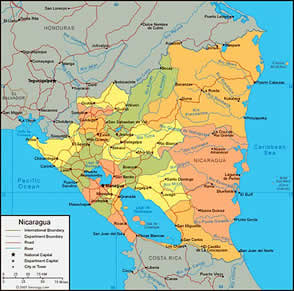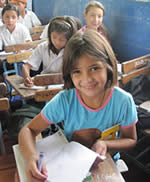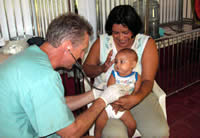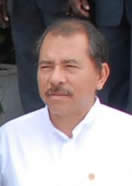| Home > Nicaragua |
NICARAGUA:
Country Profile of Nicaragua
The Republic of Nicaragua is the largest country on the Central American isthmus. The country is situated entirely within the tropics and is bordered by Honduras to the north and Costa Rica to the south, with The Pacific Ocean and the Caribbean Sea laying to the west and to the east, respectively.
Nicaragua has a multi-ethnic population, consisting of indigenous native tribes (from the Mosquito Coast), Europeans, Africans, Asians, and people of Middle Eastern origin. The principal language spoken is Spanish; tribes on the eastern coast speak their native languages, such as Sumo and Rama, as well as English Creole.
Nicaragua has a multi-ethnic population, consisting of indigenous native tribes (from the Mosquito Coast), Europeans, Africans, Asians, and people of Middle Eastern origin. The principal language spoken is Spanish; tribes on the eastern coast speak their native languages, such as Sumo and Rama, as well as English Creole.
|
☻Capital: - Managua ☻Area: - Total: 130,375 km² - Water (%): 7,14 ☻Independence: - from Spain: September 15, 1821 - Recognised: July 25, 1850 |
☻Official languages: - Spanish 98% (official); English and indigenous languages on Atlantic coast ☻Population: - 2012 census: 6,071,045 - Density: 51/km² (155th) 114/sq mi |
Geography of Nicaragua:
 Nicaragua is bordered by Honduras to the north and Costa Rica to the south. The Caribbean lies to the east of the country; the Pacific Ocean lies to the west. Nicaragua's abundance of biologically unique ecosystems, coupled with its warm tropical climate, makes the country an increasingly popular tourist destination. Almost one fifth of the country´s land is designated protected areas such as nature reserves and national parks.
Nicaragua is bordered by Honduras to the north and Costa Rica to the south. The Caribbean lies to the east of the country; the Pacific Ocean lies to the west. Nicaragua's abundance of biologically unique ecosystems, coupled with its warm tropical climate, makes the country an increasingly popular tourist destination. Almost one fifth of the country´s land is designated protected areas such as nature reserves and national parks.In Nicaragua, there are three distinct geographical regions:
- the Pacific lowlands
- the Amerrisque Mountains (North-central highlands),
- the Mosquito Coast (Atlantic lowlands)
The Pacific lowlands extend about 75 kilometres inland from the Pacific coast. Much of this area is flat, except for a line of volcanoes, many of which are still active. In this part of the country, the largest freshwater lakes in Central America can be found: Lago de Managua and Lago de Nicaragua. Surrounding the lakes and extending to the northwest of the country are fertile lowland plains enriched with volcanic ash from the nearby volcanoes. The lowlands are densely populated and well cultivated; however, because in this part of the country two major tectonic plates collide, there are frequently small earthquakes and volcanic eruptions.
The Amerrisque Mountains are composed of high ridges and a mixed forest of oak and pine alternating with deep valleys. The dry western slopes of the central highlands, protected from the moist winds of the Caribbean by the ridges of the highlands, have drawn farmers from the Pacific region since colonial times. On the contrary, the eastern slopes are among the wettest places in the world. Because the area is too wet for agriculture, the economy here is dominated by timber extraction.
The eastern Caribbean lowlands of Nicaragua form the extensive and still sparsely populated lowland area known as the Costa de Mosquitos. This part of the country is a hot, humid area that includes coastal plains, the eastern spurs of the central highlands, and the lower portion of the Río San Juan basin. The soil in this area is generally infertile.
Education in Nicaragua:
 Elementary education in Nicaragua is free of cost, and has been mandatory since 1877. Education is paid for via taxes for all Nicaraguans. However, shortages of facilities and teachers, especially in rural areas, have hampered educational development, and many children in rural areas are still unable to attend school.
Elementary education in Nicaragua is free of cost, and has been mandatory since 1877. Education is paid for via taxes for all Nicaraguans. However, shortages of facilities and teachers, especially in rural areas, have hampered educational development, and many children in rural areas are still unable to attend school.Most of Nicaragua´s higher education institutions are based in the capital city of Managua. According to law, higher education has financial, organic and administrative autonomy. Nicaragua's higher education system consists of universities, colleges and technical institutes that specialize in areas such as computer systems and sciences, electronics, agroforestry, construction and trade-related services. In 2005, almost 400,000 Nicaraguans held a university degree. Nearly 20% of Nicaragua's total budget is invested in primary, secondary and higher education.
As of 1979, the educational system in Nicaragua was considered to be one of the poorest in Latin America. Under the Somoza dictatorships, limited spending on education and generalized poverty forced many adolescents into the labor market. The newly elected Sandinista government in 1980 started an extensive and successful literacy campaign, using secondary school students, university students and teachers as volunteer teachers. This reduced the overall illiteracy rate from over 50% to 12.9% within only five months. This was one of a number of large-scale programs which received international recognition for their gains in literacy, health care, education, childcare, unions, and land reform. Today, the literacy rate in Nicaragua is still below 70%.
Although the Sandinista government increased spending on education and reduced illiteracy significantly, shortages of facilities and personnel have remained problematic.
Health in Nicaragua:
 At the end of the Somoza era, most Nicaraguans had no or limited access to modern health care. Malnutrition, inadequate water and sewage systems, and sporadic application of basic public health measures led to many diarrheal diseases in addition to pneumonia, tetanus and measles.
At the end of the Somoza era, most Nicaraguans had no or limited access to modern health care. Malnutrition, inadequate water and sewage systems, and sporadic application of basic public health measures led to many diarrheal diseases in addition to pneumonia, tetanus and measles.Nicaraguans depend on a health system that reflects the fundamental inequalities in their society. The upper class uses private health care and often goes abroad for specialized treatment. A minority of salaried workers in government and industry are served by the Nicaraguan Social Security Institute. And the remainder of the population, approaching 90 percent, is poorly served at public facilities that are generally inadequately staffed and underequipped. The health care services are concentrated in the larger cities, the rural areas being largely unserved.
The Sandinista government restructured the entire health care system in the early 1980s. The authorities combined the medical functions of the Ministry of Health, the Nicaraguan Social Security Institute, and other health care agencies from the Somoza-era, into a unified health care system. Over the next several years, spending on health care was significantly increased. Access to services was broadened and equalized, and more focus was placed on primary and preventive medicine. Various new hospitals were built (largely with foreign aid), and a national network of primary care health clinics was created. Oral Rehydration Centers were established with the help of UNICEF to treat severe childhood diarrhea, the leading cause of infant deaths. In these years there was a substantial drop in infant mortality and reductions in the incidence of transmittable diseases such as polio, pertussis, and measles.
Unfortunately, some of the ground that was gained in the first decade of the 1980s was lost during the second half of the decade. Health care activities, including vaccination campaigns, were restricted in regions with armed conflict. Due to the increase in poverty among the population, many children grew more vulnerable to disease. The economic decline and tight budgetary restraints of this period resulted in shortages basic medical supplies. While in the early 1980s, many students chose to enter the medical field, the deteriorating salaries drove many doctors out of public employment toward the end of the decade.
Despite these problems, the Sandinista decade left behind an overall improved health care system. The Chamorro government inherited a system that emphasized preventive and primary care, while targeting the principal causes of infant, child, and maternal mortality. More people now had access to the health system. The oral rehydration centers, the wide coverage of vaccination campaigns, and the key role of the health brigadistas, have all been maintained by the new government.
Politics in Nicaragua:
 Nicaragua achieved its independence from Spain in 1821. Since then, the country has undergone periods of political unrest, dictatorship, and fiscal crisis. These factors have been the most notable causes leading to the Nicaraguan Revolution in the 1960s and 1970s. The Somoza dictatorship began in 1979 and the Sandinista National Liberation Front governed from 1979 until 1990. Their campaign focused on reforming country´s society and economy along socialist lines.
Nicaragua achieved its independence from Spain in 1821. Since then, the country has undergone periods of political unrest, dictatorship, and fiscal crisis. These factors have been the most notable causes leading to the Nicaraguan Revolution in the 1960s and 1970s. The Somoza dictatorship began in 1979 and the Sandinista National Liberation Front governed from 1979 until 1990. Their campaign focused on reforming country´s society and economy along socialist lines.Nicaragua is now a presidential representative democratic republic. The President is head of state as well as head of government, and there is a multi-party system. The president is elected for a 5-year term and chooses the ministers of the cabinet.
Nicaragua has over 30 registered political parties, but the country is dominated by just 2 main parties: the Liberal Alliance and the Sandinista National Liberation Front. The first is a coalition of 5 moderate to conservative parties that support economic reforms. The Sandinista National Liberation Front is now a social democratic party and has been back in government since 2006, when Daniel Ortega was elected president.
Since 1990, the government has undertaken a variety of reforms to restructure the economy and liberalize the nation's political system. There have been broad reforms of the army and the national police force; many state-owned companies have been privatized and foreign investment in the country has increased significantly. Nicaragua has experienced economic growth over the past years, but continues to be among the poorest countries in the Americas, with almost 50% of the population living below the poverty line.
Freedom of speech is a right guaranteed by the Nicaraguan constitution. There is no state censorship. Other constitutional freedoms include peaceful assembly and association, and freedom of religion.